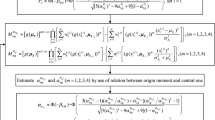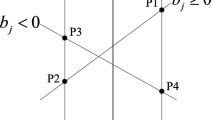Abstract
The probability density function (PDF) of a performance function can be constructed from the perspective of first four statistical moments, and the failure probability can be evaluated accordingly. Since the shifted generalized lognormal distribution (SGLD) model will be fitted to recover the PDF based on the first four statistical moments, the evaluation of statistical moments of the performance function is of critical significance for the structural reliability analysis. This paper presents a new method for statistical moments and reliability assessment of structures with efficiency and accuracy, especially when large variabilities in the input random vector and nonlinearities are considered . First, a numerical method is established based on rotating the points in the quasi-symmetric point method (Q-SPM), which is very efficient for evaluating the statistical moments. This numerical method is called the rotational quasi-symmetric point method (RQ-SPM). The optimal angles of rotation in RQ-SPM can be determined via an optimization problem, where the objective function is adopted as minimizing the differences between the marginal moments of input random variables estimated by the points after rotation and their exact values. By doing so, the information of marginal distributions and their tail distributions could be better reproduced, which is of paramount importance to the statistical moments assessment of the performance function, especially for the high-order moments. Once the statistical moments are available, the PDF of the performance function can be recovered by the SGLD model. Finally, the failure probability can be evaluated by a simple integral over the PDF of the performance function. Several numerical examples are given to demonstrate the efficacy of the proposed method. Comparisons of the new method, the original Q-SPM, the univariate dimension reduction method (UDRM) and the bivariate dimension reduction method (BDRM) are also made on the statistical moments assessment. The results manifest the accuracy and efficiency of the proposed method for both the statistical moments and reliability assessment of structures.













Similar content being viewed by others
References
Bernardo FP (2015) Performance of cubature formulae in probabilistic model analysis and optimization. J Comput Appl Math 280:110–124
Breitung K, Faravelli L (1994) Log-likelihood maximization and response surface in reliability assessment. Nonlinear Dyn 5(3):273–285
Chen J, Zhang S (2013) Improving point selection in cubature by a new discrepancy. SIAM J Sci Comput 35(5):A2121–A2149
Chen J, Yuan S (2014a) Dimension reduction of the fpk equation via an equivalence of probability flux for additively excited systems. J Eng Mech 140(11):04014088
Chen J, Yuan S (2014b) Pdem-based dimension-reduction of fpk equation for additively excited hysteretic nonlinear systems. Probab Eng Mech 38:111–118
Chen J, Yang J, Li J (2016) A gf-discrepancy for point selection in stochastic seismic response analysis of structures with uncertain parameters. Struct Saf 59:20–31
Choi M, Sweetman B (2010) The hermite moment model for highly skewed response with application to tension leg platforms. J Offshore Mech Arctic Eng 132(2):950–956
Cohen AC, Whitten BJ (1980) Estimation in the three-parameter lognormal distribution. J Am Stat Assoc 75(370):399–404
Cools R (2003) An encyclopaedia of cubature formulas. J Complex 19(3):445–453
Fan W, Wei J, Ang HS, Li Z (2016) Adaptive estimation of statistical moments of the responses of random systems. Probab Eng Mech 43:50–67
Franko M, Nagode M (2015) Probability density function of the equivalent stress amplitude using statistical transformation. Reliab Eng Syst Saf 134:118–125
He J, Gong J (2016) Estimate of small first passage probabilities of nonlinear random vibration systems by using tail approximation of extreme distributions. Struct Saf 60:28–36
Hong HP (1998) An efficient point estimate method for probabilistic analysis. Reliab Eng Syst Saf 59(3):261–267
Ibrahim RA (1987) Structural dynamics with parameter uncertainties. Appl Mech Rev, 40(3)
Isaacson E, Keller HB (1994) Analysis of numerical methods. Math Comput 20(7):99–99
Li J, Chen J (2009) Stochastic dynamics of structures. Wiley
Li G, Zhang K (2011) A combined reliability analysis approach with dimension reduction method and maximum entropy method. Struct Multidiscip Optim 43(1):121–134
Li HS, Li ZZ, Yuan XK (2008) Nataf transformation based point estimate method. Chinese Sci Bull 53 (17):2586
Low YM (2013) A new distribution for fitting four moments and its applications to reliability analysis. Struct Saf 42(3):12–25
Nadarajah S (2005) A generalized normal distribution. J Appl Stat 32(7):685–694
Nie J, Ellingwood BR (2000) Directional methods for structural reliability analysis. Struct Saf 22(3):233–249
Qiu ZP, Wang L (2016) The need for introduction of non-probabilistic interval conceptions into structural analysis and design. Sci Chin 59(11):114632
Rahman S, Wei D (2006) A univariate approximation at most probable point for higher-order reliability analysis. Int J Solids Struct 43(9):2820–2839
Rosenblueth E (1975) Point estimates for probability moments. Proc Natl Acad Sci USA 72(10):3812–3814
Singh R, Lee C (1993) Frequency response of linear systems with parameter uncertainties. J Sound Vib 168(1):71–92
Victoir N (2004) Asymmetric cubature formulae with few points in high dimension for symmetric measures. Siam J Numer Anal 42(1):209–227
Wallace DL (1958) Asymptotic approximations to distributions. Ann Math Stat 29(3):635–654
Wang X, Wang L, Elishakoff I, Qiu Z (2011) Probability and convexity concepts are not antagonistic. Acta Mech 219(1-2):45–64
Wang L, Wang X, Su H, Lin G (2016) Reliability estimation of fatigue crack growth prediction via limited measured data. Int J Mech Sci 121:44–57
Wang L, Liu D, Yang Y, Wang X, Qiu Z (2017) A novel method of non-probabilistic reliability-based topology optimization corresponding to continuum structures with unknown but bounded uncertainties. Comput Methods Appl Mech Eng 326:573–595
Winterstein SR (1988) Nonlinear vibration models for extremes and fatigue. J Eng Mech 114(10):1772–1790
Winterstein SR, Kashef T (2000) Moment-based load and response models with wind engineering applications. J Sol Energy Eng 122(3):122–128
Xiao S, Lu Z (2016) Structural reliability analysis using combined space partition technique and unscented transformation. J Struct Eng 142(11):04016089
Xiao S, Lu Z (2017) Reliability analysis by combining higher-order unscented transformation and fourth-moment method. ASCE-ASME J Risk Uncertain Eng Sys Part A: Civil Eng 4(171):04017034
Xiong F, Greene S, Chen W, Xiong Y, Yang S (2009) A new sparse grid based method for uncertainty propagation. Struct Multidiscip Optim 41(3):335–349
Xu J (2016) A new method for reliability assessment of structural dynamic systems with random parameters. Struct Saf 60:130–143
Xu H, Rahman S (2004) A generalized dimension-reduction method for multidimensional integration in stochastic mechanics. Int J Numer Methods Eng 61(12):1992–2019
Xu J, Li J (2016) Stochastic dynamic response and reliability assessment of controlled structures with fractional derivative model of viscoelastic dampers. Mech Syst Signal Process 72:865–896
Xu J, Lu Z (2017) Evaluation of moments of performance functions based on efficient cubature formulation. ASCE’s J Eng Mech. https://doi.org/10.1061/(ASCE)EM.1943-7889.0001248
Xu J, Wang D (2017) A two-step methodology to apply low-discrepancy sequences in reliability assessment of structural dynamic systems. Struct Multidiscip Optim 57(4):1643–1662
Xu J, Kong F (2018) An adaptive cubature formula for efficient reliability assessment of nonlinear structural dynamic systems. Mech Syst Signal Process 104(104):449–464
Xu J, Chen J, Li J (2012) Probability density evolution analysis of engineering structures via cubature points. Comput Mech 50(1):135–156
Xu J, Wang D, Dang C (2016) A marginal fractional moments based strategy for points selection in seismic response analysis of nonlinear structures with uncertain parameters. J Sound Vibr 387:226–238
Xu J, Zhang W, Sun R (2016) Efficient reliability assessment of structural dynamic systems with unequal weighted quasi-monte carlo simulation. Comput Struct 175:37–51
Xu J, Dang C, Kong F (2017) Efficient reliability analysis of structures with the rotational quasi-symmetric point- and the maximum entropy methods. Mech Syst Signal Process 95:58–76
Zhang X, Pandey MD (2013) Structural reliability analysis based on the concepts of entropy, fractional moment and dimensional reduction method. Struct Saf 43:28–40
Zhang X, Pandey MD (2014) An effective approximation for variance-based global sensitivity analysis. Reliab Eng Syst Saf 121(4):164–174
Zhao YG, Ono T (2000) New point estimates for probability moments. J Eng Mech 126(4):433–436
Zhou J, Nowak AS (1988) Integration formulas to evaluate functions of random variables. Struct Saf 5 (4):267–284
Acknowledgments
The research reported in this paper is supported by the National Natural Science Foundation of China (Grant No.: 51608186), Natural Science Foundation of Hunan Province (No.2017JJ3016) and the Fundamental Research Funds for the Central Universities (No.531107040890). The support is gratefully appreciated. The reviewers are highly appreciated for their constructive comments to improve the original manuscript.
Author information
Authors and Affiliations
Corresponding author
Additional information
Publisher’s Note
Springer Nature remains neutral with regard to jurisdictional claims in published maps and institutional affiliations.
Rights and permissions
About this article
Cite this article
Xu, J., Kong, F. An efficient method for statistical moments and reliability assessment of structures. Struct Multidisc Optim 58, 2019–2035 (2018). https://doi.org/10.1007/s00158-018-2015-2
Received:
Revised:
Accepted:
Published:
Issue Date:
DOI: https://doi.org/10.1007/s00158-018-2015-2




